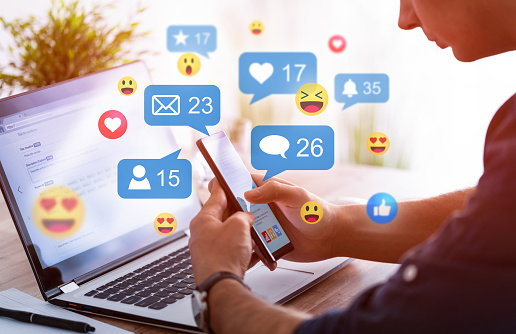Social Media: Society’s Sneaky and Scary Addiction

February 16, 2021
Nearly all of us grew up alongside the development of social media, and it is worth remembering that we are still susceptible to the largely unprecedented effects that it may have. As another generation is set to be raised in the age of the Internet, and as we begin to enter adulthood, social media platforms and their addictive nature are falling under greater scrutiny.
One of the features that has been investigated is the “endless scroll”. It has been an integral part of social media platforms since the heyday of Myspace and Friendster. The endless scroll is a built-in function located in the “feed”, where the center of interaction and content can be found. The purpose of the endless scroll is to create a never-ending stream of content based on who you follow or interact with. Algorithms gauge your interest and deliver similar posts related to your interests, keeping you engaged and offering a truly infinite scroll.
The convenient accessibility of billions of bits of information and data at the literal touch of a finger has posed notable consequences for its users, and lead to a ripple effect within the social media industry. This may bode well for social media companies, but it certainly does not for users.
Social Media’s Shortening
Posts on the very first social media platforms bear a closer resemblance to blog posts then today’s limited character tweets.
As the Internet grew in usage and numbers, engagement began to be judged by different parameters. The number of people visiting and the time they spent on the site became a form of currency to the then-fledgling social media platforms. Character limits began to shorten and became a key aspect of the social stratosphere as sites tried to condense more interesting content in the same amount of space.
Endless scroll moved on from the longer in-depth pieces of the past to posts that would rarely exceed four lines of text. New photo and video sharing features coupled with sites such as LinkedIn, Spotify, and Pinterest, which filled in specific niches; these developments only continue the rapid-fire nature of social media.
Today, the future of social media seems to be shorter-time limits to videos and “stories”, with many sites adopting Snapchat’s core feature of sharable, expiring snapshots. However, social media posts are not the only thing shortening.
A survey of Canadian media consumption by Microsoft concluded that the average attention span had fallen to eight seconds, down from 12 in the year 2000. That means we now have a shorter attention span than goldfish.
Companies know that social media is altering the way we consume and process information as we grow more accustomed to using fewer words in our content. In fact, they take advantage of it.
You see it in the press, the obsession with Buzzfeed’s mindless listicles that are provocative and tempting enough to click. You see it in our politics, with fear-mongering slogans replacing anything that requires sustained thought. You see it in the collapse of a fact-based democracy. For example, according to Climate Chat, a website dedicated to conversations about climate change, 30% of Americans do not believe climate change is happening.
Social media is clearly hurting us.
The New News cycle
The sensational nature of news and reporting has roots dating back to the invention of the printing press in 1456 when mass dispersion of information and news became available. Fast forward to the mid-1600s, printing became available in America, and the country set up its first printing press at Harvard University. During this period, writers were free to accept, refuse, and print whatever their whims dictated. As a result, the government needed to censor writers and printers until the freedom of the press was later established.
In the 1920s, we started to see some of the early developments in professional journalism. Throughout the years, this style has been echoed in the gripping front-page headlines of print media and the “in-the-moment” news reporting of cable television today.
Exaggeration and possible misrepresentation is not a new concept when it comes to our access to information, but social media catapults it to an entirely different scale. With platforms that actively invite and encourage user input, news moves faster than a feed can refresh. As millions of voices clamor to be heard, misinforming or manipulating the masses is easier than ever.
In a seemingly infinite stream of information, “clickbait” articles or titles that draw attention with dramatics are easily distributed to millions of people regardless of their validity or biases. This becomes even more concerning in light of a recently published study from the Pew Research Center, a nonpartisan American-based research group, which reported that 55% of adults now receive their news from social media either “often” or “sometimes.”
The ease with which a publisher can create and spread falsehoods has led to a marketplace of misinformation unprecedented in size and power. This type of click-driven journalism has recently created controversy over “fake news”, forcing social media platforms to crack down information with fact-checking initiatives and place greater emphasis on taking greater personal responsibility.

Facebook has been under fire for years regarding fake news and was called “the key vector of distribution of untrustworthy sites” by Professor Jason Reifler, from the University of Exeter. In 2019, Facebook CEO Mark Zuckerberg found himself in hot water over political ads. In a speech at Georgetown University, Zuckerberg said, “we don’t fact-check political ads…We don’t do this to help politicians, but because we think people should be able to see for themselves what politicians are saying.” Zuckerberg did not fact check political ads due to the First Amendment’s protections for the freedom of speech. While Mr. Zuckerberg’s intentions might seem pure, as the freedom of speech is certainly very important to have our voices heard, protecting false, inaccurate speech is extremely deafening.
Firstly, social media companies are not liable for user-generated content. The First Amendment protects free speech, including hate speech and false speech, but Section 230 shields social media platforms and websites from liability for content created by their users. This means Mr. Zuckerberg can certainly moderate and screen Facebook’s posts for false information, without being legally accountable for infringing on people’s First Amendment rights.
Secondly, allowing false speech ultimately presents a threat to our democratic institutions. People’s vulnerability to fake news means that they are far more likely to believe inaccurate political information, and are therefore unable to make informed decisions when voting, making it harder to see the truth. Because a democratic system relies on an informed populace to determine how it should act through votes, fake news presents a unique threat to U.S. democracy.
Having an endless stream of social media posts encourages users to deceive, mislead, and entice other users through false speech just to gain more clicks. This is a common problem in American media, and it is only getting worse.
So, What Now?
Now, some people may say that we, the rising Generation Z, have it “easier” than previous generations due to technology and social media. To an extent, that is true. Social media is a powerful resource with an outreach that spans the globe. You can reach out to an old friend, network, and gain more inspiration from others faster and efficiently. In the face of what is going on, it is imperative that we stay informed. Social media has been ingrained into us, it has encouraged us to stay informed, and given us easier access to news. However, while it may seem like the whole world is within our grasp, it is not all rainbows and butterflies.
Social media is a different world than it is for many adults, especially those who did not grow up with it. We are faced with the constant and seemingly endless pressure of social media.
The pressure to be perfect on social media, especially the more visual-based platforms like Instagram, and the pressure to learn and keep up with the constantly evolving technology, connecting with influencers and bloggers, and the constant struggle to gain more followers is exhausting.
Although social media has brought many negatives, it is not budging from its cultural and global significance any time soon. For the foreseeable future, endless scroll will continue to be a part of our lives and the “new normal” that awaits us. In the right hands, social media can be used powerfully and drive you towards a successful path. In the wrong hands…you already know about its consequences. What we should not forget moving forward is that we have control over our social media usage and how actively we rely on it as a source.
We have a choice in what we are seeing on the screen. We need to recognize our limits and the toll social media has taken on us, in addition to viewing what we see on our timelines with a grain of salt (and a bit of fact-checking). It is our job to use social media and handle technology responsibly.




